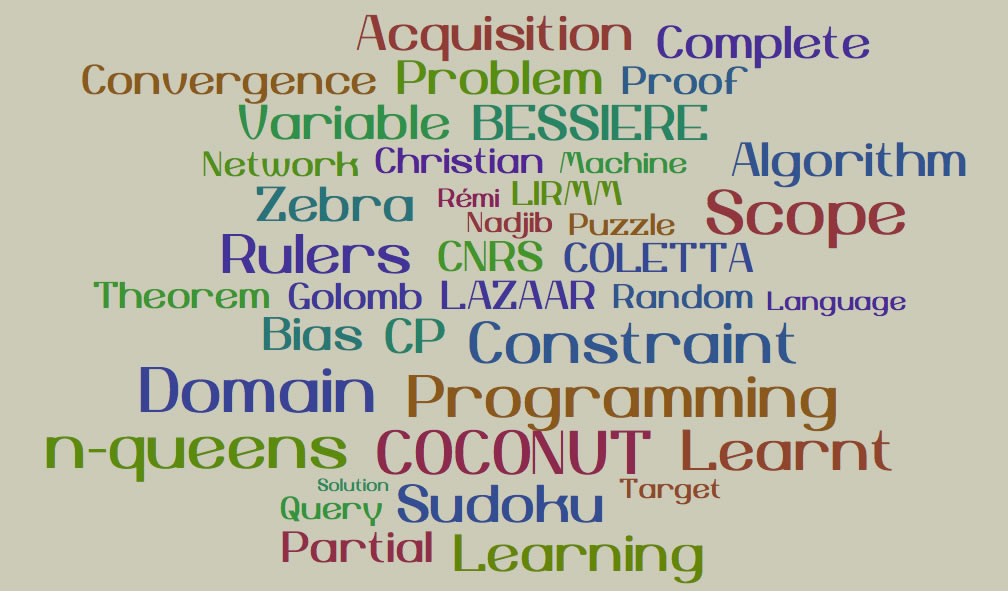
A major bottleneck in the use of constraint solvers is modelling. How does the user write down the constraints of a problem? Several techniques have been proposed to tackle this bottleneck. For example, the matchmaker agent [Freuder and Wallace, 1998] interactively asks the user to provide one of the constraints of the target problem each time the system proposes an incorrect solution. In Conacq.1 [Bessiere et al., 2004; 2005], the user provides examples of solutions and non-solutions. Based on these examples, the system learns a set of constraints that correctly classifies all examples given so far. This is a form passive learning. In [Lallouet et al., 2010], a system based on inductive logic programming uses background knowledge on the structure of the problem to learn a representation of the problem correctly classifying the examples. A last passive learner is ModelSeeker [Beldiceanu and Simonis, 2012]. Positive examples are provided by the user to the system which arranges each of them as a matrix and identifies constraints in the global constraints catalog that are satisfied by rows or columns of all examples. The weakness of the passive learning approach is that the user is not always able to provide enough informative examples (i.e., sufficiently heterogeneous) to let the learner learn the target set of constraints.
By contrast, in an active learner like Conacq.v2 [Bessiere et al., 2007], the system proposes examples to the user to classify as solutions or non solutions. Such questions are called membership queries [Angluin, 1987]. Such active learning has several advantages. It can decrease the number of examples necessary to converge to the target set of constraints. Another advantage is that the user need not be a human. It might be a previous system developed to solve the problem. For instance, the Normind company has recently hired a constraint programming specialist to transform their expert system for detecting failures in electric circuits in Airbus airplanes in to a constraint model in order to make it more efficient and easier to maintain. As another example, active learning is used to build a constraint model that encodes non-atomic actions of a robot (e.g., catch a ball) by asking queries of the simulator of the robot in [Paulin et al., 2008]. Such active learning introduces two computational challenges. First, how does the system generate a useful query? Second, how many queries
are needed for the system to converge to the target set of constraints?
It has been shown that the number of membership queries required to converge to the target set of constraints can be exponentially large [Bessiere and Koriche, 2012].
In our last work, we propose QUACQ (for QuickAcquisition),
an active learner that asks the user to classify partial queries.
Given a negative example, QUACQ is able to learn a constraint of the target constraint network in a number of queries logarithmic in the number of variables. In fact, we identify information theoretic lower bounds on the complexity of learning constraint networks which show that QUACQ is optimal on some simple languages. We demonstrate the promise of this approach in practice with some experimental results.
One application for QUACQ would be to learn a general purpose model. In constraint programming, a distinction is made between model and data. For example, in a sudoku puzzle, the model contains generic constraints like each subsquare contains a permutation of the numbers. The data, on the other hand, gives the pre-filled squares for a specific puzzle.
As a second example, in a time-tabling problem, the model specifies generic constraints like no teacher can teach multiple classes at the same time. The data, on the other hand, specifies particular room sizes, and teacher availability for a particular time-tabling problem instance. The cost of learning the model can then be amortized over the lifetime of the model. Another advantage of this approach is that it provides less of a burden on the user. First, it often converges quicker than other methods. Second, partial queries will be easier to answer than complete queries. Third, as opposed to existing techniques, the user does not need to give positive examples.
This might be useful if the problem has not yet been solved, so there are no examples of past solutions.